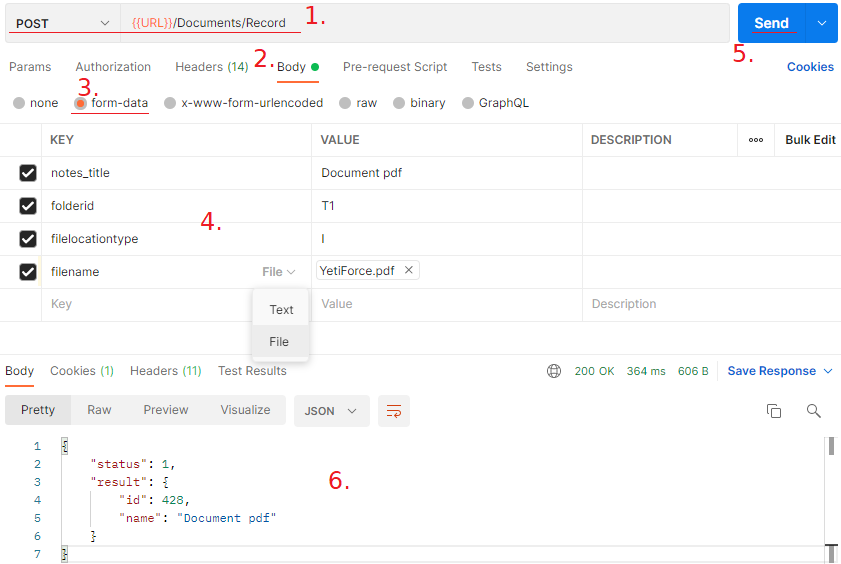Jak przez Rest Api dodać dokument z załącznikiem
6.2.0 i późniejW tym artykule znajdziesz informacje jak za pomocą Rest Api dodać wpis w module Dokumenty wraz z załącznikiem
Przed przejściem dalej należy zapoznać się z dostępnymi metodami i sposobem komunikacji z api opisanymi tutaj: https://doc.yetiforce.com/api/
1. Tworzenie dokumentu z załącznikiem
Do utworzenia wpisu w module Dokumenty należy wykorzystać metodę api umożliwiającą tworzenie rekordu, tj.
https://doc.yetiforce.com/api/#/BaseModule/ea3b9bea091cbde741323b5393901825
Cała trudność w dodawaniu załącznika polega na odpowiednim przygotowaniu zapytania. Standardowo w zapytaniu należy odpowiednio uzupełnić pola modułu i w tym przypadku nie będzie inaczej.
Nazwy pól modułu dostępne są w panelu edycji pól w konfiguracji systemu: Konfiguracja systemu -> Moduły standardowe -> Moduły - pola
Pola odpowiedzialne za dodanie załącznika to:
-
Typ pliku [filelocationtype]
Pole to określa typ załącznika. Dostępne są dwie wartości: I - Wewnętrzny, E - Zewnętrzny
-
Nazwa pliku/WWW [filename]
Załącznik lub odnośnik
Posiadając już wiedzę o strukturze modułu Dokumenty można przejść do wysyłania zapytań do api. Poniżej kilka przykładów konstrukcji tego typu zapytań:
Postman

Guzzle, PHP HTTP client
https://github.com/guzzle/guzzle
$uri = 'https://example.com/webservice/RestApi/Documents/Record';
$options = [
'headers' => [
'User-Agent' => 'YetiForceRestApi',
'x-api-key' => 'P0fzRUuzPNWC9pxYq3MeEUp6AJ9EJpWN',
'x-token' => '9c65f656c9380b7066d992ec59c00c0d29147a579351742b0e9f43a73312f5be',
],
'auth' => ['userName', 'Password'],
'timeout' => 10,
'connect_timeout' => 2
];
$httpClient = new \GuzzleHttp\Client($options);
$options['multipart'] = [
['name' => 'notes_title', 'contents' => 'Document pdf'],
['name' => 'filelocationtype', 'contents' => 'I'],
[
'name' => 'filename',
'filename' => 'YetiForce.pdf',
'contents' => file_get_contents('YetiForce.pdf')
]
];
$response = $httpClient->request('POST', $uri, $options)->getBody()->getContents();
cURL, PHP
$url = 'https://example.com/webservice/RestApi/Documents/Record';
$headers = [
'User-Agent: YetiForceRestApi',
'x-api-key: P0fzRUuzPNWC9pxYq3MeEUp6AJ9EJpWN',
'x-token: 9c65f656c9380b7066d992ec59c00c0d29147a579351742b0e9f43a73312f5be',
'Content-Type: multipart/form-data'
];
$userName = 'userName';
$password = 'Password';
$cf = new CURLFile(realpath('YetiForce.pdf'));
$ch = curl_init();
curl_setopt($ch, CURLOPT_URL, $url);
curl_setopt($ch, CURLOPT_HTTPHEADER, $headers);
curl_setopt($ch, CURLOPT_HTTPAUTH, CURLAUTH_ANY);
curl_setopt($ch, CURLOPT_USERPWD, "{$userName}:{$password}");
curl_setopt($ch, CURLOPT_RETURNTRANSFER, true);
curl_setopt($ch, CURLOPT_POST, true);
curl_setopt($ch, CURLOPT_POSTFIELDS, ['notes_title' => 'Document pdf', 'filelocationtype' => 'I', 'filename' => $cf]);
$response = curl_exec($ch);
2. Powiązanie utworzonego dokumentu z innym wpisem.
Istnienie dokumentu niepowiązanego w systemie jest bezcelowe, dlatego każdy utworzony wpis w module Dokumenty powinien zostać przypisany do rekordu innego modułu, np. Kontaktu, Kontrahenta, Zgłoszenia czy dowolnego innego, z którym istnieje taka możliwość.
Nie trzeba tworzyć osobnych zapytań do api celem powiązania dokumentu, czynność tę można wykonać bezpośrednio przy jego tworzeniu, dodając kilka dodatkowych zmiennych, i są nimi:
-
relationOperation (bool) /obowiązkowe
Określa, iż tworzony wpis podlega powiązaniu
-
sourceModule (string) /obowiązkowe
Nazwa modułu, z którym należy powiązać utworzony dokument
-
sourceRecord (int) /obowiązkowe
Identyfikator rekordu, z którym należy powiązać utworzony dokument
-
relationId (int) /opcjonalne
Identyfikator relacji między modułami
Obowiązkowe, jeśli istnieje więcej niż jedna relacja między modułami
Przykładowy plik:
$httpClient = new \GuzzleHttp\Client($options);
$options['multipart'] = [
['name' => 'notes_title', 'contents' => 'Document pdf'],
['name' => 'filelocationtype', 'contents' => 'I'],
[
'name' => 'filename',
'filename' => 'YetiForce.pdf',
'contents' => file_get_contents('YetiForce.pdf')
],
['name' => 'relationOperation', 'contents' => true],
['name' => 'sourceModule', 'contents' => 'Contacts'],
['name' => 'sourceRecord', 'contents' => 124]
];
$response = $httpClient->request('POST', $uri, $options)->getBody()->getContents();